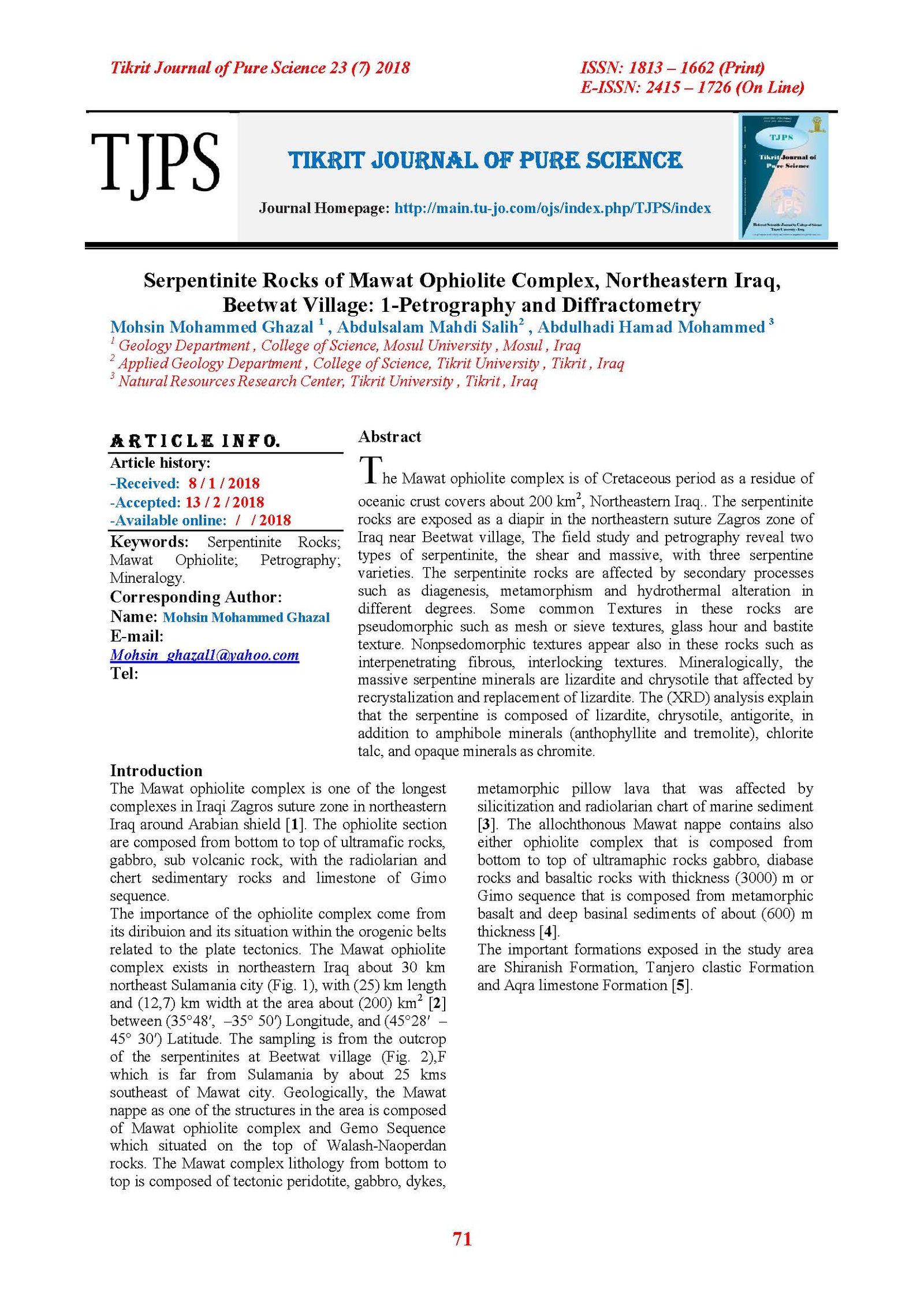Serpentinite Rocks of Mawat Ophiolite Complex, Northeastern Iraq, Beetwat Village: 1-Petrography and Diffractometry
Main Article Content
Abstract
The Mawat ophiolite complex is of Cretaceous period as a residue of oceanic crust covers about 200 km2, Northeastern Iraq.. The serpentinite rocks are exposed as a diapir in the northeastern suture Zagros zone of Iraq near Beetwat village, The field study and petrography reveal two types of serpentinite, the shear and massive, with three serpentine varieties. The serpentinite rocks are affected by secondary processes such as diagenesis, metamorphism and hydrothermal alteration in different degrees. Some common Textures in these rocks are pseudomorphic such as mesh or sieve textures, glass hour and bastite texture. Nonpsedomorphic textures appear also in these rocks such as interpenetrating fibrous, interlocking textures. Mineralogically, the massive serpentine minerals are lizardite and chrysotile that affected by recrystalization and replacement of lizardite. The (XRD) analysis explain that the serpentine is composed of lizardite, chrysotile, antigorite, in addition to amphibole minerals (anthophyllite and tremolite), chlorite talc, and opaque minerals as chromite.
Article Details

This work is licensed under a Creative Commons Attribution 4.0 International License.
Tikrit Journal of Pure Science is licensed under the Creative Commons Attribution 4.0 International License, which allows users to copy, create extracts, abstracts, and new works from the article, alter and revise the article, and make commercial use of the article (including reuse and/or resale of the article by commercial entities), provided the user gives appropriate credit (with a link to the formal publication through the relevant DOI), provides a link to the license, indicates if changes were made, and the licensor is not represented as endorsing the use made of the work. The authors hold the copyright for their published work on the Tikrit J. Pure Sci. website, while Tikrit J. Pure Sci. is responsible for appreciate citation of their work, which is released under CC-BY-4.0, enabling the unrestricted use, distribution, and reproduction of an article in any medium, provided that the original work is properly cited.
References
[1]- Ricou, L.E. (1974): Le Croissant Ophiolitique Peri-Arab: Une ceinture de nappes mises en place an Cretace superieur. Rev. Geogr. Phys. Geol. Dyn., Vol.13, pp. 327-349.
[2]- Coleman, R.G. (1981): Ophiolites, Springer-Verlag, New York, 229 p.
[3]- Al-Hashimi, A.R. and Al-Mehaidi, H.M. (1975): Cu-Ni-Cr dispersion in Mawat ophiolite complex, NE Iraq. Jour. Geol. Soc. Iraq, Spec. Issue, pp. 37-44.
[4]- Aswad, K. J. (1999): Arc-continental collision in Northeastern Iraq as evidence by the Mawat and Penjwen ophiolite complex. Raf. J. Sci., Vol. 10, pp. 51–61.
[5]- Al-Mehaidi, H. M. (1975): Tertiary nappe in Mawat range NE Iraq. J. Geol. Soc. Iraq, Vol. VII, pp. 31–44.
[6]- Hassanipak, A. A. and Ghazi, A. M. (2000): Petrology, geochemistry and tectonic setting of the Khoy ophiolite northwest Iran: Implications for Tethyan tectonics. J. Asian Earth Sci., Vol. 18, P. 109 – 121.
[7]- Parlak, O., Hock, V., Kazlu, H. and Delaloye, M. (2004): Oceanic crust generation in an island arc tectonic setting, SE Anatolian orogenic belt (Turkey). Geol. Mag., Vol. 141, P. 583 – 603.
[8]- Lugovic, B., Altherr, R., Raczek. I., Hofmann, A.W. and Majer, V. (1991): Geochemistry of peridotites and mafic igneous rocks from Central Dinaric Ophiolite Belt, Yugoslavia. Contrib. Mineral. Petrol., Vol.106, pp.201-216.
